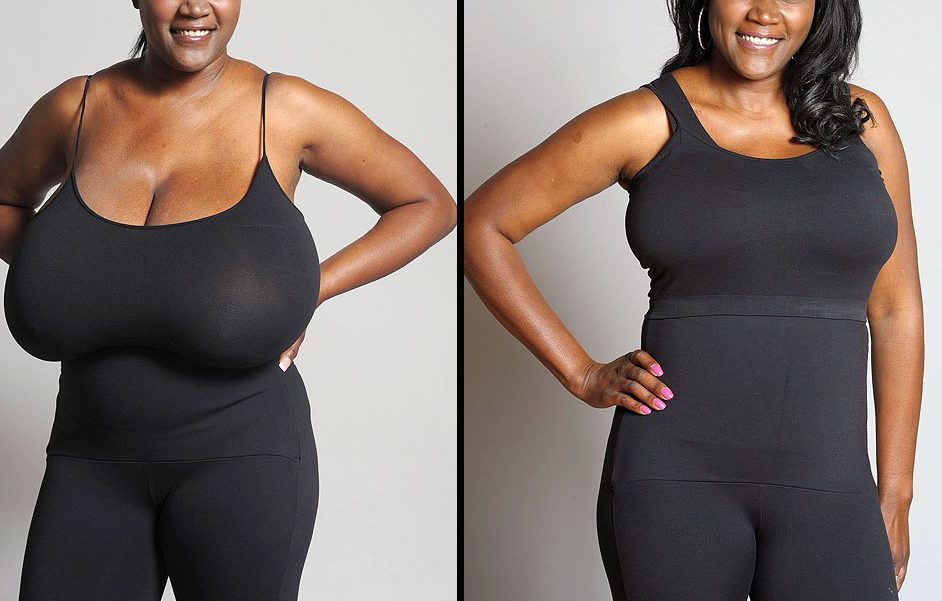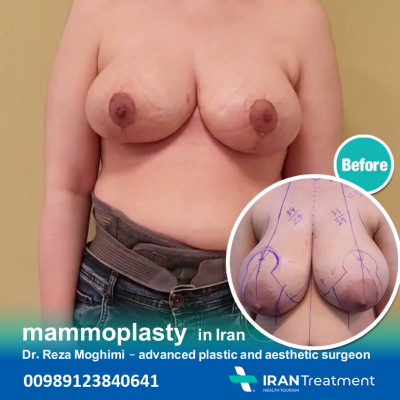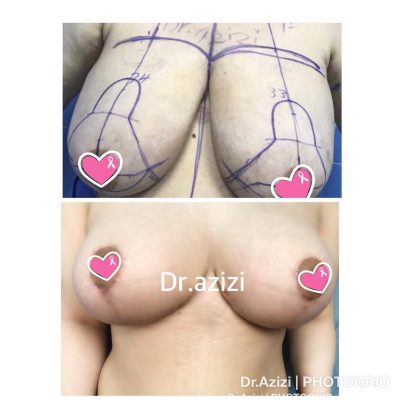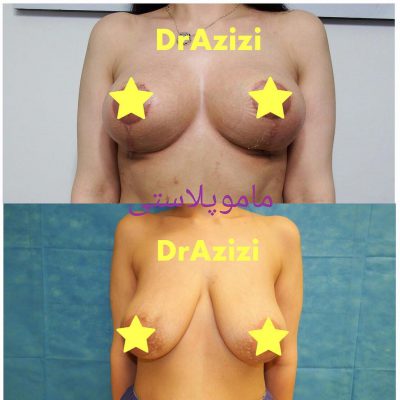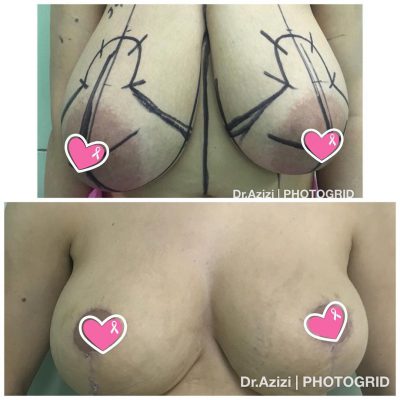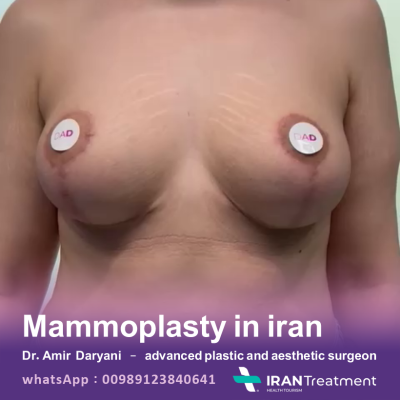Breast Reduction in Iran
Reduction mammoplasty, also known as Breast Reduction in Iran, is a procedure to reduce the size of large breasts. It aims to decrease the size and weight of the breasts, relieve associated symptoms like back/neck pain, and improve breast symmetry. The surgery removes excess breast fat, glandular tissue, and skin to reduce and reshape the breast. It is a major surgery and the recovery period can last several weeks.
Some important things to know about Breast Reduction in Iran:
• It is usually done under general anesthesia. The procedure typically takes 3 to 5 hours.
• Incisions are made around the areola and vertically below the breast, resulting in scars that fade over time but do not completely disappear.
• Excess fat, glandular tissue, and skin are removed. The nipple-areola complex is often repositioned higher on the breast.
• Patients usually stay in the hospital for 1-2 nights after surgery. Drainage tubes are inserted to remove excess fluid and are removed after a week or so.
• It can take several weeks to return to normal daily activities. Patients need to limit arm movement and lifting during recovery. Most swelling and bruising resolve within a month.
• Potential risks include bleeding, infection, loss of nipple sensation, breast asymmetry, and scarring. When performed by an experienced plastic surgeon, serious complications are rare.
• Long term results are significant reduction in breast size, improved breast symmetry, alleviation of symptoms, and high patient satisfaction with the cosmetic outcome.
• Health insurance often covers all or part of the procedure due to the medical benefits. Multiple options are available to finance the cosmetic portion of the surgery if desired.
• Additional procedures like breast lift may be combined with breast reduction for optimal results. Follow up surgery may also be needed to refine the results.
Breast Reduction surgery cost in Iran
Reduction mammoplasty cost in Iran Between 1,700 and 2,300 dollars
| The cost of Reduction mammoplasty in Iran includes the following | |
| Surgeon’s salary | Between 1,700 and 2,300 dollars |
| Hospital and operating room fees | |
| The cost of pre-surgery tests | About 50 dollars |
| Drug cost | |
| The cost of a 9-day stay in Iran | 300 dollars on average |
| Transportation costs | Optional |
| The cost of care after surgery | Optional |
| The cost of a special garment after surgery | Between 50 and 70 dollars |
| Breast reduction surgery package cost in Iran (without flight cost) | Between 2,100 and 2,700 dollars |
Breast Reduction in Iran Package
What results can be expected from reduction mammaplasty ?
some common results of Breast Reduction in Iran may include:
1. Reduced breast size: The primary goal of breast reduction surgery is to reduce the size of the breasts. This can help alleviate physical discomfort and improve the patient’s ability to engage in physical activity.
2. Improved breast shape: In addition to reducing breast size, reduction mammaplasty can also improve the shape of the breasts, making them more proportionate to the patient’s body.
3. Relief from physical symptoms: Many women with large breasts experience physical symptoms such as back pain, neck pain, shoulder pain, and rashes under the breasts. Breast Reduction in Iran can alleviate these symptoms and improve the patient’s overall comfort and quality of life.
4. Enhanced self-confidence: Women with large breasts may feel self-conscious or embarrassed about their appearance. Reduction mammaplasty can help improve self-confidence and body image, leading to a better quality of life.
5. Improved clothing fit: After Breast Reduction in Iran, patients may find that their clothing fits better and they have more options when it comes to choosing clothing styles.
It is important to note that while reduction mammaplasty can provide significant physical and emotional benefits, it is also a major surgical procedure that carries some risks and potential complications. Patients should discuss the potential risks and benefits of the procedure with their surgeon before making a decision.
Breast Reduction in Iran risks and complications
Like any surgical procedure, reduction mammoplasty (breast reduction surgery in Iran ) carries some risks and potential complications. Some possible risks and complications of the procedure include:
1. Bleeding: Excessive bleeding can occur during or after surgery, which may require a blood transfusion or additional surgery to address.
2. Infection: Infection is a risk with any surgical procedure, and patients undergoing breast reduction surgery are at risk of developing a postoperative infection, which may require antibiotics or further surgery.
3. Scarring: Reduction mammoplasty requires incisions, which may result in visible scars. While surgeons take care to minimize scarring, the final appearance of scars can vary depending on the patient’s healing process and the surgical technique used.
4. Changes in nipple sensation: Breast Reduction in Iran can cause temporary or permanent changes in nipple sensation, including numbness or hypersensitivity.
5. Difficulty breastfeeding: Breast Reduction in Iran can result in a reduced ability to breastfeed, although this is less likely with modern surgical techniques.
6. Asymmetry: While surgeons strive to create symmetrical breasts, there is always the possibility of asymmetry, which may require additional surgery to correct.
7. Anesthesia risks: As with any surgery, there is a risk of complications associated with anesthesia, including allergic reactions and respiratory problems.
Here’s a general overview of the mammoplasty surgery procedure:
1. Preoperative assessment and consultation:
Before the surgery, you’ll have a consultation with your plastic surgeon to discuss your goals, expectations, and any potential risks. The surgeon will evaluate your overall health and take detailed measurements of your breasts, including their size, shape, and skin quality. This information will help the surgeon determine the best technique and approach for your surgery.
2. Anesthesia:
Mammoplasty is typically performed under general anesthesia, which means you’ll be unconscious for the entire duration of the surgery. In some cases, local anesthesia with sedation may be used.
3. Incision:
The surgeon will make an incision in the breast area, the location of which will depend on the type of mammoplasty being performed. Common incision locations include:
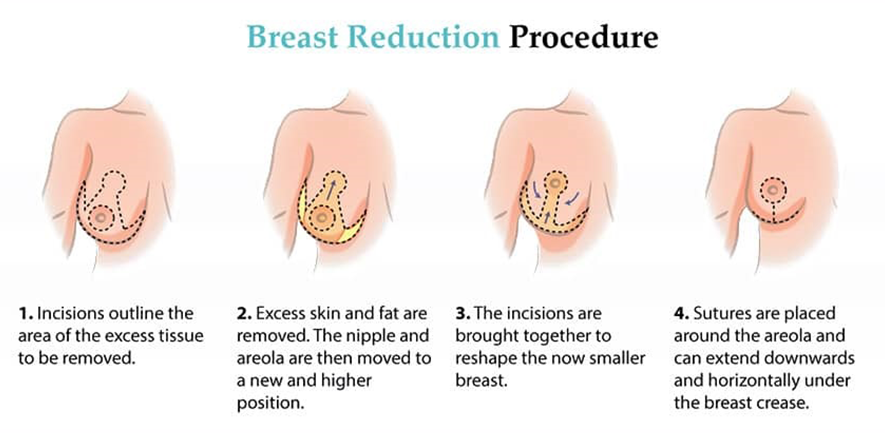
Anchor incision: This incision is also known as an inverted-T or Wise pattern incision. It starts around the areola and extends down to the crease under the breast, and then along the crease in both directions. This incision allows the surgeon to remove a significant amount of tissue and reshape the breast, but it can result in more scarring than other incision types.
Lollipop incision: This incision involves making a circular incision around the areola and a vertical incision down to the breast crease. This incision is often used for moderate reductions and can result in less scarring than the anchor incision.
Donut incision: This incision is also known as a periareolar incision and involves making a circular incision around the areola. This incision is used for smaller reductions and can result in minimal scarring, but it may not be suitable for larger reductions.
The incision size and location are chosen to minimize visible scarring and to allow for the best possible outcome.
4. Breast tissue modification:
– Breast Reduction in Iran: The surgeon will remove excess breast tissue, fat, and skin to achieve a smaller breast size. They may also reposition the nipple and areola to a more aesthetically pleasing location.
5. Closing the incisions:
Once the desired modifications are completed, the surgeon will close the incisions using sutures, surgical tape, or adhesive. Drains may be placed in the incision area to prevent fluid build-up during the healing process.
6. Recovery:
After the surgery, you’ll be taken to a recovery room where your vital signs will be monitored. You may experience pain, swelling, and bruising in the days following the surgery. Your surgeon will provide you with postoperative care instructions and pain management strategies to help you through the healing process.
7. Follow-up appointments:
You’ll have follow-up appointments with your surgeon to monitor your progress and ensure proper healing. The surgeon will remove any drains or sutures and address any concerns or complications that may arise.
Aftercare of reduction mammoplasty surgery
The aftercare following reduction mammoplasty surgery is very important for a successful outcome and to minimize risks. The key aspects of post-operative care include:
• Rest: Getting plenty of rest is important for recovery. Limit activities and avoid any strenuous exercise for 4-6 weeks. Take time off work if needed.
• Dressings: Gauze dressings and surgical bras are applied after surgery to minimize swelling and support the breasts during initial healing. Bandages are usually removed after 1-2 days but surgical bras need to be worn for several weeks.
• Drains: Drainage tubes are inserted during surgery to remove excess fluid from the surgical sites. These are removed after 7-14 days once drainage lessens. Keep the drains supported and empty the attached bulbs 3 times a day.
• Wound care: The incisions around the areola and below the breasts are closed with sutures. Steri-strips and sometimes Dermabond are also applied. Keep the incisions clean and dry. Sutures are removed after 1-2 weeks.
• Medications: Oral pain medications, antibiotics, and other medications are prescribed as needed to manage pain, reduce risk of infection, and promote healing. Take as directed.
• Follow up: Close follow up with the surgeon is needed after discharge. Usually visits are weekly for the first month to monitor healing and look for any complications.
• Activity: Gradually return to light activities over 4-6 weeks. Avoid any exercise other than casual walking for at least a month. Do not lift arms over shoulder level or lift anything heavy for 6 weeks. Driving is usually allowed after 2 weeks if not taking any narcotics.
• Support: Additional support devices such as compression bandages or camisoles may be recommended to minimize swelling and offer comfort during the initial few weeks of recovery.
• Recovery: It can take 3-6 months for full recovery including resolution of swelling and scars. Final results of surgery may take 6-12 months as the reshaped breasts settle into their new position. Patience is needed through the long but rewarding recovery process.
Breast Reduction in Iran – کوچک کردن سایز سینه

